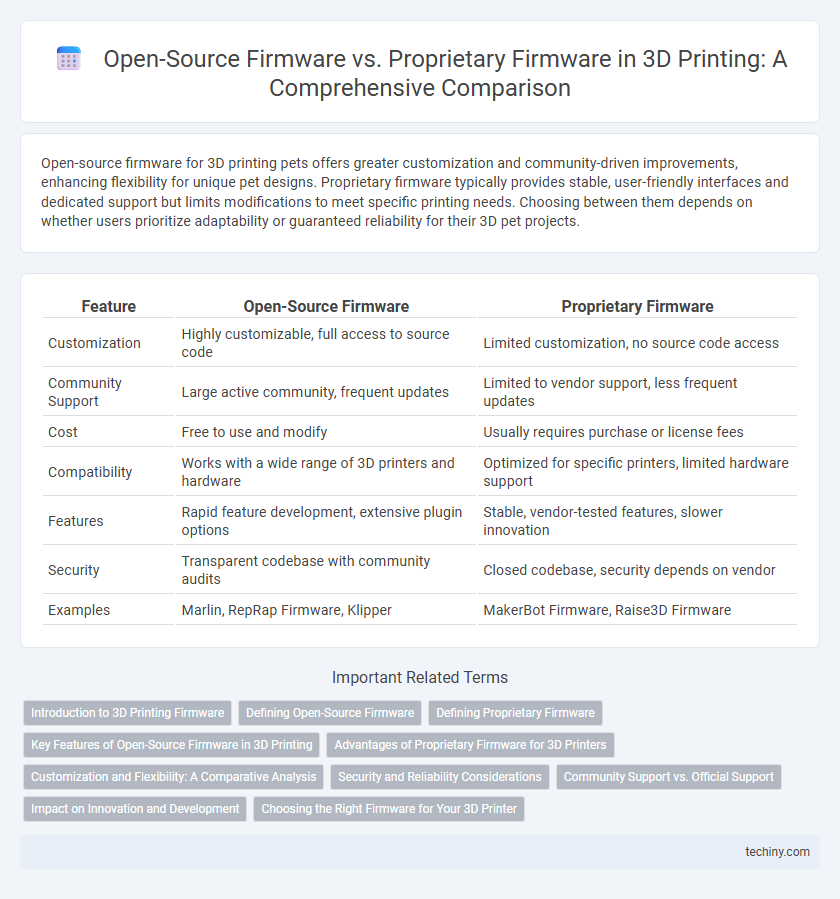Open-source firmware for 3D printing pets offers greater customization and community-driven improvements, enhancing flexibility for unique pet designs. Proprietary firmware typically provides stable, user-friendly interfaces and dedicated support but limits modifications to meet specific printing needs. Choosing between them depends on whether users prioritize adaptability or guaranteed reliability for their 3D pet projects.
Table of Comparison
| Feature | Open-Source Firmware | Proprietary Firmware |
|---|---|---|
| Customization | Highly customizable, full access to source code | Limited customization, no source code access |
| Community Support | Large active community, frequent updates | Limited to vendor support, less frequent updates |
| Cost | Free to use and modify | Usually requires purchase or license fees |
| Compatibility | Works with a wide range of 3D printers and hardware | Optimized for specific printers, limited hardware support |
| Features | Rapid feature development, extensive plugin options | Stable, vendor-tested features, slower innovation |
| Security | Transparent codebase with community audits | Closed codebase, security depends on vendor |
| Examples | Marlin, RepRap Firmware, Klipper | MakerBot Firmware, Raise3D Firmware |
Introduction to 3D Printing Firmware
3D printing firmware acts as the crucial software interface between the printer hardware and the user, controlling motor movements, temperature regulation, and sensor inputs. Open-source firmware like Marlin and Klipper offers transparency, customization, and community-driven updates, fostering innovation and adaptability in various printer models. Proprietary firmware provides manufacturers with tightly integrated features, optimized performance, and dedicated customer support but often lacks customization and limits user modifications.
Defining Open-Source Firmware
Open-source firmware in 3D printing refers to software whose source code is freely available for users to study, modify, and distribute, fostering a collaborative development environment. This transparency allows for extensive customization and community-driven improvements, enhancing printer functionality and compatibility with various hardware. Unlike proprietary firmware, open-source options like Marlin or RepRap provide users with control over their devices, supporting innovation and flexibility in 3D printing technology.
Defining Proprietary Firmware
Proprietary firmware in 3D printing refers to software developed and controlled exclusively by a company, restricting user access to source code and modification capabilities. This type of firmware often includes specialized features tailored for specific printers but limits customization and community-driven improvements. Manufacturers use proprietary firmware to ensure compatibility, maintain quality standards, and protect intellectual property.
Key Features of Open-Source Firmware in 3D Printing
Open-source firmware in 3D printing offers customizable code, enabling users to modify and optimize printer performance for specific materials and designs. It supports a wide range of hardware platforms, enhancing compatibility and user flexibility. Community-driven development ensures continuous updates, bug fixes, and feature additions, fostering innovation and reliability in 3D printing processes.
Advantages of Proprietary Firmware for 3D Printers
Proprietary firmware for 3D printers offers optimized performance and stability through dedicated development teams focused on hardware compatibility and advanced feature integration. Enhanced customer support and regular updates ensure reliability and user-friendly experiences tailored to specific printer models. Security features embedded in proprietary solutions protect against unauthorized modifications, maintaining device integrity and consistent print quality.
Customization and Flexibility: A Comparative Analysis
Open-source firmware offers unparalleled customization and flexibility for 3D printing enthusiasts, allowing users to modify code and optimize printer performance to suit specific project needs. Proprietary firmware typically provides a more stable and user-friendly experience but limits customization options due to closed-source restrictions. Choosing between the two depends on the user's technical expertise and desire for control over firmware settings versus ease of use and manufacturer support.
Security and Reliability Considerations
Open-source firmware in 3D printing enables transparency, allowing users to inspect and modify the code, which enhances security through community-driven vulnerability identification and rapid updates. Proprietary firmware often offers optimized performance and manufacturer support, but its closed nature can obscure potential security flaws and limit user control. Choosing firmware requires balancing the reliability of tested proprietary systems against the adaptable and transparent security features of open-source options.
Community Support vs. Official Support
Open-source firmware in 3D printing, such as Marlin and Klipper, benefits from extensive community support, providing rapid updates, custom features, and troubleshooting from a diverse user base. Proprietary firmware offers official support with dedicated customer service and stable updates directly from manufacturers, ensuring reliability and compatibility with specific hardware. The choice between open-source and proprietary firmware hinges on the user's preference for flexibility and community innovation versus guaranteed manufacturer assistance and tested stability.
Impact on Innovation and Development
Open-source firmware in 3D printing fosters rapid innovation by enabling developers to access, modify, and share code freely, accelerating feature development and customization. Proprietary firmware often limits user modification and transparency, potentially slowing technological advancements and restricting third-party integrations. The open ecosystem promotes collaborative problem-solving and continuous improvement, driving the evolution of more versatile and adaptive 3D printing solutions.
Choosing the Right Firmware for Your 3D Printer
Choosing between open-source and proprietary firmware for your 3D printer depends on customization needs, community support, and update frequency. Open-source firmware like Marlin offers extensive customization options and strong community-driven improvements, making it ideal for advanced users seeking flexibility. Proprietary firmware typically provides polished user interfaces and dedicated customer support, catering to users who prioritize stability and ease of use over modification capabilities.
Open-Source Firmware vs Proprietary Firmware Infographic

 techiny.com
techiny.com